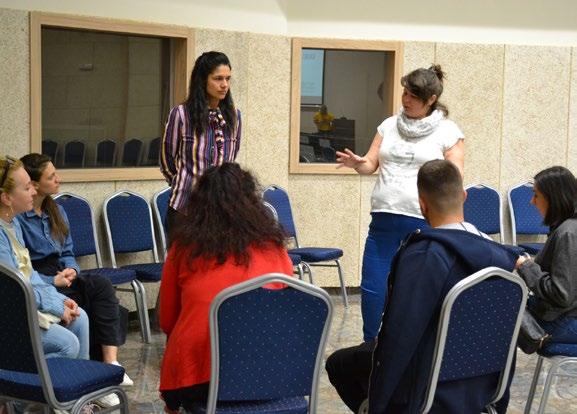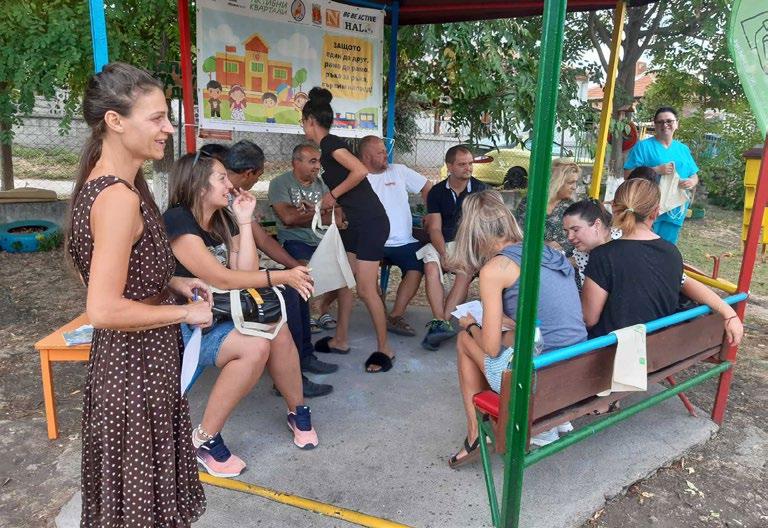
3 minute read
Tool 5: How to get input from the local community?
TOOL 5
How to get input from the local community?
Advertisement
STAGE IN THE COMMUNITY-LEAD PLACE-BASED PROCESS: Stage II. Map opportunities and challenges
PARTICIPATION LEVEL ON THE LADDER: 4. Consultation
Participation level on the ladder 8 7 6 5 4 3 2 1
WHEN TO USE THIS TOOL: Have you completed at least one of the tools in Stage I? Are you looking for an easy and intuitive tool to get feedback from your community on a planned activity? Are you ready to hear what your local community thinks?. If the answer to all of these questions is yes, you are ready to use this tool! HOW TO BEST USE THIS TOOL: It is best to use this tool together with a large group of people (+50 participants) in a community event. TYPE OF ACTIVITY: Pop-up engagement activity to ensure community participation DURATION: Preparation: 1,5-2 hours Pop-up community engagement activity: 2-4 hours (up to you). Ideally, you should repeat this activity several times under different community events.
PART 1. GETTING READY
STEP 1.
STEP 1. PREPARATION OF THE POP-UP ACTIVITY Duration: 1.5 – 2 hours
1. Making questions: Making good questions is the most important part. Get together with stakeholders and local citizens interested in the project to brainstorm what is the most important information that you want to learn from citizens.
Examples of questions:
• What type of activities would you like to engage in after school hours? • What type of events would you like to see in this square? • I would come here more often if there was [activity or infrastructure examples to put stickers on] here.
2. Print out pictures to illustrate your different options (activities, events, improvements, etc) 3. Get colored dot stickers and prepare as many stickers per person as you would like to give them votes. 4. You can also prepare a couple of flipcharts for people to give you written feedback or to suggest further ideas or activities. Remember to bring post-its, pens and something to hang up your posters 5. Try to repeat this activity several times under different community events to collect enough data and make sure you get diverse participants. 6. Duration: 2-4 hours, up to you 7. Team up with other organizations that are planning an event in your project area. 8. Go to a place where you are likely to meet your local community like schools, parks, or other types of public spaces and invite them to participate. 9. After the pop-up engagement activity count the votes and share the main results with your local community. Take the outcomes further for your implementation or next project.
PART 2. EXECUTION OF THE POP-UP ACTIVITY
DON’T FORGET: • To collect some demographic data, if you want to evaluate how different demographic/cultural/or employment groups answer different questions. You can use different colored dot stickers for this, for example, red dot stickers for adults, green for youth and yellow for children. • To take photos during these activities.
HOW TO MOVE UP ON THE LADDER:
DO: use this tool during your exploration phase to get input from your community on your planned implementation. DO: also use this tool in the evaluation/impact measurement phase to get feedback on your initiative. DO: some research about which location and type of community event can attract the desired audience if you are hoping to reach certain groups.
DON'T: wait too long to implement some of the ideas or activities after asking people to vote. DON'T: Promise anything that you won’t be able to implement!
Read more about this tool here
INSPIRATION
HOW TO MITIGATE CONFLICTS OF OPINION (FOR ADULTS AND KIDS)? By using voting and practical demonstrations of democracy!
Halo Foundation used sticker democracy to decide on the main issues surrounding the implementation of the intervention at the green kindergarten project in Stamboliyski. At the opening event, they this tool to present democracy in a practical way to kids, by having the kids try to lift a heavy bag on their own and then later all together, to show the value of working together on a chosen goal!

Read more about Halo Foundation










